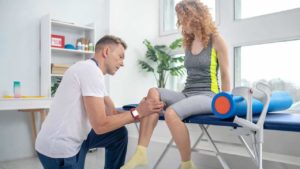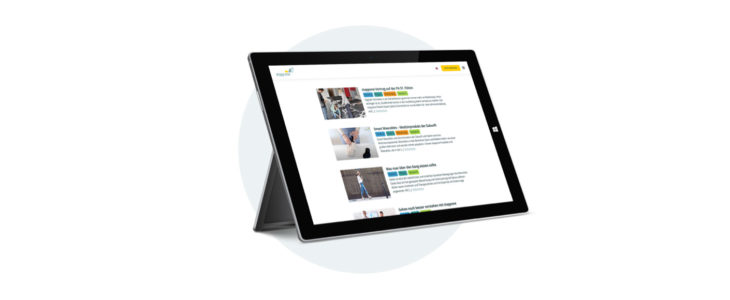Innovative rehabilitation of meniscus tears

Ruptures of the menisci often occur in sports accidents, for example while playing soccer, tennis or skiing, but also happen due to simple overstrain. Meniscus tears can be treated both conservatively and surgically. In both treatment options partial weight-bearing therapy plays a crucial role. With stapp one this therapy is now more effective than ever.
Menisci are an important component of the human knee joint. They compensate for the incongruence of the femoral condyles and the tibial plateau. In doing so, they increase the “femorotibial contact area to better distribute and reduce the load.” ¹
A meniscus tear can be traumatic or degenerative. During surgery, the function of the meniscus is restored by suturing the tear. However, proper aftercare does not mean complete immobilization, but controlled movement. Movement distributes nourishing synovial fluid in the joint, which accelerates the healing process.
Various expert papers therefore recommend partial weight-bearing exercises as post-treatment.²
Aftercare of a meniscus repair
Trauma surgeon T. Schmickal (Emergency Hospital Ludwigshafen DE) describes his approach to post-treatment in his scientific paper:
“In our own patient population, the range of motion is limited to 0°/20°/60° in the first 2 weeks, to 0°/0°/90° by the end of the 4th postoperative week; after initial unloading, floor contact with 20 kg is permitted from the 2nd postoperative week, and with 50% of the body weight after the end of the 4th week.” ³
However, therapists face a common problem here: patients do not know what 20 kg of load feels like. They are often very insecure and put far too little weight on the leg – also because they generally have to find their way back to the right perception of the own body.
stapp one for an optimal healing process
The intelligent sensor sole from stapp one is the innovative medical product for post-treatment of meniscus repairs using partial weight-bearing. The soles are inserted into comfortable shoes and measure the patient’s foot pressure load and the body’s center of gravity. The correspondent Medical Solutions Software provides a wireless live-biofeedback on a tablet or computer. In case of a post-treatment using partial weight-bearing, such as mentioned above, the therapist can set the prescribed weight-bearing limit in advance. Patients can now observe themselves using the visual, acoustic or haptic live-biofeedback and at the same time feel how much pressure load they are putting on the affected leg. In this way, they adhere precisely to the load limit and an optimal and effective training is ensured. The visual component helps as a corrective to relearn the accurate load and at the same time prevents inappropriate biomechanics stress, which contributes to the optimal healing process.
With stapp one, it is also possible to store the objective data resulting from the training and compare it with subsequent sessions to objectively visualize progress.
Do you have questions about the use of stapp one? Please contact us! We are always at your disposal.
Find us on LinkedIn and become part of our community! We keep you updated about stapp one, medicine and technology!
¹ Schmickal, T. Meniskusrefixation. Trauma Berufskrankh 8, S229–S231 (2006).
² Petersen, W., Zantop, T. Die arthroskopische Meniskusnaht. Orthop Traumatol 18, 393–410 (2006) / Schmickal, T. Meniskusrefixation. Trauma Berufskrankh 8, S229–S231 (2006).
³ Schmickal, T. Meniskusrefixation. Trauma Berufskrankh 8, S229–S231 (2006).
https://link.springer.com/article/10.1007/s10039-005-1062-2#citeas
https://link.springer.com/article/10.1007%2Fs00064-006-1185-2#citeas

